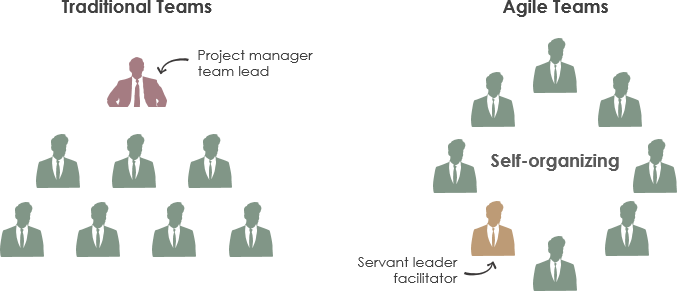A self-organizing team is a team that has the autonomy to choose how best to accomplish their work, rather than being directed by others outside the team. Unlike traditional management principles, the self-organizing empowered teams are not directed and controlled from the top; rather they evolve from team members participating actively & collectively in all the Scrum practices and events.


Best Scrum Software Every Project Needs
A powerful scrum software that supports scrum project management. It features scrum tools like user story map, product backlog management, sprint backlog management, task management, daily scrum meeting, sprint planning tool, sprint review tool, sprint retrospective tool, burndown, impediment, stakeholder and team management.
The preferred leadership style in Scrum is “servant leadership”, which emphasizes achieving results by focusing on the needs of the Scrum Team. Thus, a self-organizing team has the autonomy to make some decisions and they also take ownership of their work, and consequently, the team is likely to become more self-motivated and seek to accept greater responsibility. And as a result, they deliver much greater value when self-organized. Some of the benefits of Self-organization are:
As mentioned above, a self-organizing teams choose how best to accomplish their work, rather than being directed by managers outside the team. Members of the team have the best skills, abilities and knowledge for the job, which make them the right people to select the most efficient path to achieve the sprint goal. Self-organizing teams are important and beneficial for any Scrum team, but sometimes to build such a team could be a great challenge. Here are a few good reasons:
Adopting agile mindset and practices across the whole organization is a big challenge. It is easier said than done. This challenge is not only for the teams themselves, but even for the management who finds it difficult to reconcile the need for predictable outcomes with the demand for greater freedom and autonomy.
Benefits of self-organization mainly arise from enhanced sharing and learning. This learning can happen from peers & seniors during frequent interactions encouraged by Scrum. Learning also takes place by observing and exposure to cross-functional teams with diverse skills and backgrounds. The frequent interactions also lead to close team bonding and identification with project commitments. Thus the most essential requirement of Scrum teams is to have active participation by all team members in all Scrum events.
To building a self-organizing team, the organization should ensure that it provides the necessary infrastructure, training, and incentive system to keep employees motivated at work. Creating a self-organizing team can be considered a three-step process.

Proper training can help satisfy many of the principles that self-organizing teams require. Specifically, hard skills training can ensure competency and provide the necessary framework to conduct tests that lead to regular improvements. Meanwhile, soft skills training can help lay the groundwork for high levels of communication, collaboration, commitment, and confidence.
Before becoming a true self-organizing team, groups need coaching. They may require more support and guidance at the beginning. These are the indicators of your team getting more and more mature such as: Scrum ceremonies are productive, the team enjoys the work and members help each other, new ideas are forthcoming, and teams are pulling work for themselves. Finally, the role of the coach should diminish over time as team members learn how to take ownership and begin to collaborate with and trust one another in a self-organizing way.
Once a team starts self-organizing, the journey has only just begun. Assign mentors who can help the team go to the next level, so that the growth of the team will to be sustain in longer run. For example, job rotations can be an important aspect of keeping employees involved and of encouraging continuous learning, as this kind of mentoring could help with continuity by ensuring everyone grows together and remains motivated.
| About Visual Paradigm |
 Visual Paradigm help organizations stay competitive and responsive to change faster and better in today’s fast changing environment. Our award-winning products are trusted by over 320,000 users in companies ranging from small business, consultants, to blue chip organizations, universities and government units across the globe. It enables organizations to improve business and IT agility and foster innovation through popular open standards and process frameworks.Visual Paradigm, a killer Agile feature in 2018, introduced Scrum Process Canvas for automating the way a Scrum team to create, manage and deploy software application that empowers the team to continuously improve their performance at unprecedented speed and scale. Visual Paradigm help organizations stay competitive and responsive to change faster and better in today’s fast changing environment. Our award-winning products are trusted by over 320,000 users in companies ranging from small business, consultants, to blue chip organizations, universities and government units across the globe. It enables organizations to improve business and IT agility and foster innovation through popular open standards and process frameworks.Visual Paradigm, a killer Agile feature in 2018, introduced Scrum Process Canvas for automating the way a Scrum team to create, manage and deploy software application that empowers the team to continuously improve their performance at unprecedented speed and scale.
Manage the Entire Scrum Process in One Page
|